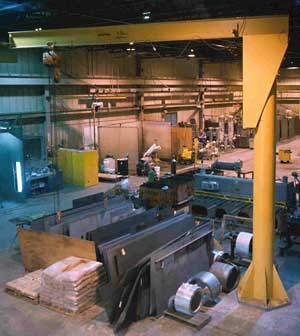
Ergonomic jib cranes are a cost-effective, easy to incorporate form of material handling for your plant or work space. In our last blog post, we talked about the different styles of ergonomic Jib Cranes. Today we’ll dive into how jib cranes increase safety and productivity.
How Do Jib Cranes Contribute to Safety in the Workplace?
Ergonomic jib cranes contribute to safety at workplaces in many ways. Let's look at the top four ways they do this. Jib cranes:
1. Help to reduce injuries
Injuries related to handling or lifting objects or materials are common in the workplace, accounting for most workplace injuries. Jib cranes are famous for their safety. They minimize the number of sprains, strains, and other injuries by tripping, slipping, or falling. These injuries are sustained mainly by employees when trying to lift loads over 50 pounds. A jib crane provides a safe means of lifting and moving loads, thus promoting workplace safety.
2. Help reduce overcrowding
Ergonomic jib cranes are relatively smaller than traditional cranes, hence saving space. Overcrowded plants and warehouses leave workers at a greater risk of injury. Installing ergonomic jib cranes can help you maximize space, clean up crowded aisles, enable free movement of floor employees, and help prevent workplace injuries.
3. Have fewer components, fewer breakdowns
Jib cranes are much simpler in design and have a smaller number of parts compared to traditional cranes. Because they have fewer components, jib cranes rarely break down. If a crane breaks down during an operation, it can injure the operator or floor employee working nearby.
4. Have a simpler design that promotes safety training
Training your production staff in safety is vital when deploying a jib crane or any piece of equipment at the workplace. Jib cranes have a simple design and fewer components and moving parts. This makes it easy for staff to learn how to operate it safely and perform regular inspections.
How Do Jib Cranes Increase Productivity Rates?
Jib cranes can help you boost productivity by offering the following benefits:
1. Easy and fast installation
A fast and straightforward installation minimizes production downtime. Installing jib cranes is relatively easy, with the only challenging part of the installation being confirming whether the building's walls and columns can support the jib crane.
2. Quick adjustments equate to a little downtime
Businesses need to adapt their equipment and operations to address evolving production demands. Jib cranes come with a console bearing that allows production staff to make quick adjustments without disassembling the crane. Quick adjustments help minimize production downtime.
3. Require less maintenance than larger cranes
Jib cranes require little preventive maintenance, thus further minimizing production downtime. The de-installation process is also relatively straightforward, so relocating a jib crane to another area in a different capacity is easy.
4. Maximize loading and unloading efficiency
The ability for jib cranes to rotate makes them an excellent addition to loading docks and machining areas. They can quickly unload heavy loads from flatbed trucks, pivot, and lay them on a concrete floor.
5. One crane can be used across several workstations
If your facility has several workstations lined up against a single wall, you can install a traveling wall mounted jib crane that can cross the entire wall and serve your workstations. This configuration is especially suitable for facilities with occasional rather than continual lifting requirements.
6. Have superb strength
Jib cranes are not only impressive ergonomically, but they're also surprisingly strong. While the maximum lifting capacity varies by style and model, jibs are built to support a load on their own, and the rest of the jib crane is also made strong.
7. Supplement existing cranes
Jib cranes have a lesser-known advantage of working alongside giant cranes to give additional support. For example, you can use a free-standing jib with an overhead crane.
Bottom Line
Jib cranes are moderately simple in design but can have good lifting capacities of 250 lbs. to 15 tons. They are essential in all lifting processes because they relieve the overhead crane of a lot of work and reduce the waiting time.
Jib cranes are often used in a smaller work cell area to load and unload products safely and efficiently. Their ergonomic design makes them an excellent choice for a production environment because they maximize worker productivity, minimize workplace injuries, and enhance safety.